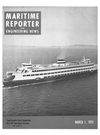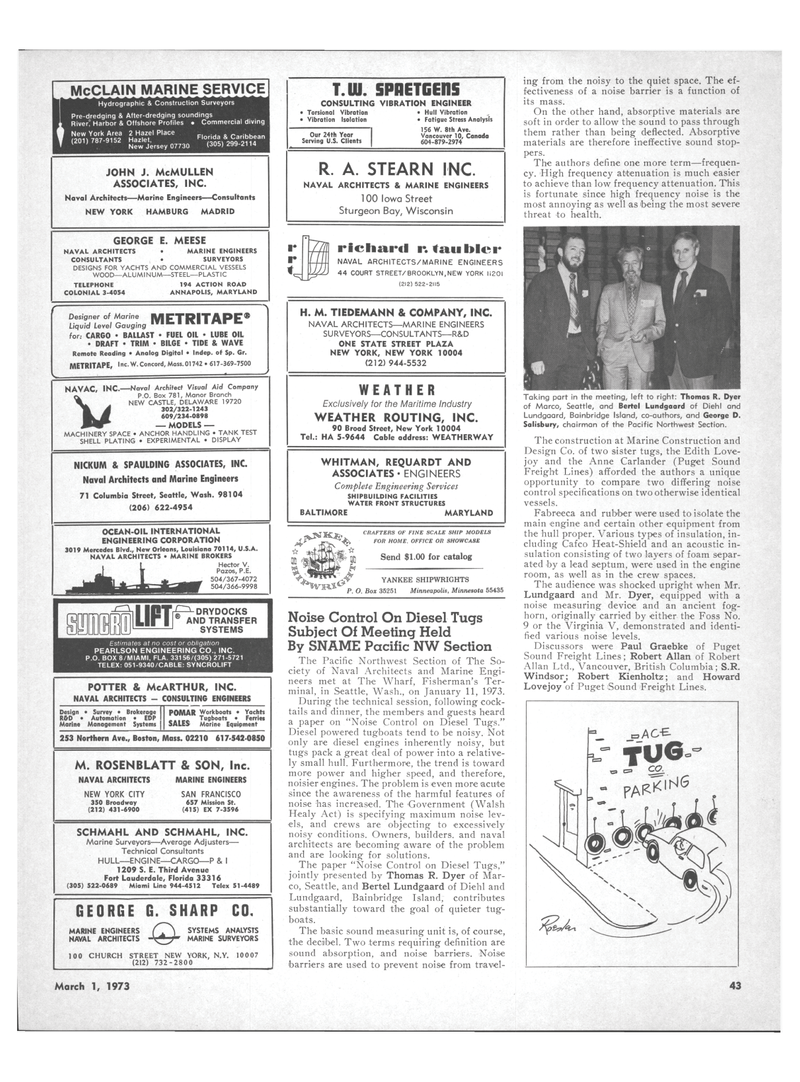
Page 35: of Maritime Reporter Magazine (March 1973)
Read this page in Pdf, Flash or Html5 edition of March 1973 Maritime Reporter Magazine
McCLAIN MARINE SERVICE
Hydrographic & Construction Surveyors
Pre-dredging & Atter-dredging soundings
RiverJ Harbor & Offshore Profiles • Commercial diving
I2MWKMH Ha""?9'3" Florida & Caribbean (201) 787-9152 Hazlej, ^ ^ (305) 299.2114
JOHN J. McMULLEN
ASSOCIATES, INC.
Naval Architects—Marine Engineers—Consultants
NEW YORK HAMBURG MADRID
GEORGE E. MEESE
NAVAL ARCHITECTS • MARINE ENGINEERS
CONSULTANTS • SURVEYORS
DESIGNS FOR YACHTS AND COMMERCIAL VESSELS
WOOD—ALUMINUM—STEEL—PLASTIC
TELEPHONE 194 ACTION ROAD
COLONIAL 3-4054 ANNAPOLIS, MARYLAND
Designer of Marine MFTPITAPF®
Liquid Level Gauging IT,t 1 1 for: CARGO • BALLAST • FUEL OIL • LUBE OIL • DRAFT • TRIM • BILGE • TIDE & WAVE
Remote Reading • Analog Digital • Indep. of Sp. Gr.
METRITAPE, Inc. W.Concord, Mass.01742 • 617-369-7500
NAVAC, INC. Naval Architect Visual Aid Company rv P O. Box 781, Manor Branch
V „ NEW CASTLE, DELAWARE 19720
Tk A 302/322-1243 609/234-0898 — MODELS —
MACHINERY SPACE • ANCHOR HANDLING • TANK TEST
SHELL PLATING • EXPERIMENTAL • DISPLAY
NICKUM & SPAULDING ASSOCIATES, INC.
Naval Architects and Marine Engineers 71 Columbia Street, Seattle, Wash. 98104 (206) 622-4954
OCEAN-OIL INTERNATIONAL
ENGINEERING CORPORATION 3019 Mercedes Blvd., New Orleans, Louisiana 70114, U.S.A.
NAVAL ARCHITECTS • MARINE BROKERS
Hector V.
Pazos, P.E. 504/367-4072 504/366-9998
LIFT m. DRYDOCKS AND TRANSFER SYSTEMS
Estimates at no cost or obligation
PEARLSON ENGINEERING CO., INC.
P.O. BOX 8/MIAMI, FLA. 33156/(305)271-5721
TELEX: 051-9340/CABLE: SYNCROLIFT
POTTER & McARTHUR, INC.
NAVAL ARCHITECTS - CONSULTING ENGINEERS
Design • Survey • Brokerage
R&D • Automation • EDP
Marine Management Systems
POMAR Workboats • Yachts
Tugboats • Ferries
SALES Marine Equipment 253 Northern Ave., Boston, Mass. 02210 617-542-0850
M. ROSENBLATT & SON, Inc.
NAVAL ARCHITECTS MARINE ENGINEERS
NEW YORK CITY 350 Broadway (212) 431-6900
SAN FRANCISCO 657 Mission St. (415) EX 7-3596
SCHMAHL AND SCHMAHL, INC.
Marine Surveyors—Average Adjusters—
Technical Consultants
HULL—ENGINE—CARGO—P & I 1209 S. E. Third Avenue
Fort Lauderdale, Florida 33316 (305) 522-0689 Miami Line 944-4512 Telex 51-4489
GEORGE G. SHARP CO.
MARINE ENGINEERS
NAVAL ARCHITECTS
SYSTEMS ANALYSTS
MARINE SURVEYORS 100 CHURCH STREET NEW YORK, N.Y. 10007 (212) 732-2800
T. 111. SPIIETGEI15
CONSULTING VIBRATION ENGINEER • Torsional Vibration • Hull Vibration • Vibration Isolation • Fatigue Stress Analysis
Our 24th Year 156 W. 8th Ave.
Serving U.S. Clients 604-879-2974
R. A. STEARN INC.
NAVAL ARCHITECTS & MARINE ENGINEERS 100 Iowa Street
Sturgeon Bay, Wisconsin rielistrcl r.faiibler
NAVAL ARCHITECTS/MARINE ENGINEERS 44 COURT STREET/BROOKLYN,NEW YORK 11201 (212) 522-2115
H. M. TIEDEMANN & COMPANY, INC.
NAVAL ARCHITECTS—MARINE ENGINEERS
SURVEYORS—CONSULTANTS—R&D
ONE STATE STREET PLAZA
NEW YORK, NEW YORK 10004 (212) 944-5532
WEATHER
Exclusively for the Maritime Industry
WEATHER ROUTING, INC. 90 Brood Street, New York 10004
Tel.: HA 5-9644 Cable address: WEATHERWAY
WHITMAN, REQUARDT AND
ASSOCIATES - ENGINEERS
Complete Engineering Services
SHIPBUILDING FACILITIES
WATER FRONT STRUCTURES
BALTIMORE MARYLAND
CRAFTERS OF FINE SCALE SHIP MODELS
FOR HOME. OFFICE OR SHOWCASE
Send $1.00 for catalog
YANKEE SHIPWRIGHTS
P. O. Box 35251 Minneapolis, Minnesota 55435
Noise Control On Diesel Tugs
Subject Of Meeting Held
By SNAME Pacific NW Section
The Pacific Northwest Section of The So- ciety of Naval Architects and Marine Engi- neers met at The Wharf, Fisherman's Ter- minal, in Seattle, Wash., on January 11, 1973.
During the technical session, following cock- tails and dinner, the members and guests heard a paper on "Noise Control on Diesel Tugs."
Diesel powered tugboats tend to be noisy. Not only are diesel engines inherently noisy, but tugs pack a great deal of power into a relative- ly small hull. Furthermore, the trend is toward more power and higher speed, and therefore, noisier engines. The problem is even more acute since the awareness of the harmful features of noise :has increased. The Government (Walsh
Healy Act) is specifying maximum noise lev- els, and crews are objecting to excessively noisy conditions. Owners, builders, and naval architects are becoming aware of the problem and are looking for solutions.
The paper "Noise Control on Diesel Tugs," jointly presented by Thomas R. Dyer of Mar- co, Seattle, and Bertel Lundgaard of Diehl and
Lundgaard, Bainbridge Island, contributes substantially toward the goal of quieter tug- boats.
The basic sound measuring unit is, of course, the decibel. Two terms requiring definition are sound absorption, and noise barriers. Noise 'barriers are used to prevent noise from travel- ing from the noisy to the quiet space. The ef- fectiveness of a noise barrier is a function of its mass.
On the other hand, absorptive materials are soft in order to allow the sound to pass through them rather than being deflected. Absorptive materials are therefore ineffective sound stop- pers.
The authors define one more term—frequen- cy. High frequency attenuation is much easier to achieve than low frequency attenuation. This is fortunate since high frequency noise is the most annoying as well as being the most severe threat to health.
Taking part in the meeting, left to right: Thomas R. Dyer of Marco, Seattle, and Bertel Lundgaard of Diehl and
Lundgaard, Bainbridge Island, co-authors, and George D.
Salisbury, chairman of the Pacific Northwest Section.
The construction at Marine Construction and
Design Co. of two sister tugs, the Edith Love- joy and the Anne Carlander (Puget Sound
Freight Lines) afforded the authors a unique opportunity to compare two differing noise control specifications on two otherwise identical vessels.
Fabreeca and rubber were used to isolate the main engine and certain other equipment from the hull proper. Various types of insulation, in- cluding Cafco Heat-Shield and an acoustic in- sulation consisting of two layers of foam separ- ated by a lead septum, were used in the engine room, as well as in the crew spaces.
The audience was shocked upright when Mr.
Lundgaard and Mr. Dyer, equipped with a noise measuring device and an ancient fog- horn, originally carried by either the Foss No. 9 or the Virginia V, demonstrated and identi- fied various noise levels.
Discussors were Paul Graebke of Puget
Sound Freight Lines; Robert Allan of Robert
Allan Ltd., Vancouver, British Columbia; S.R.
Windsor; Robert Kienholtz; and Howard
Lovejoy of Puget Sound Freight Lines.
March 1, 1973 43

 34
34

 36
36
